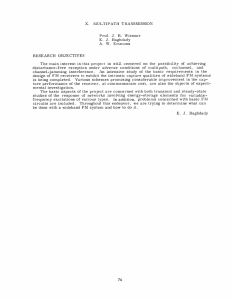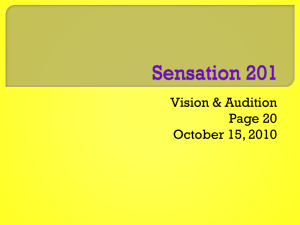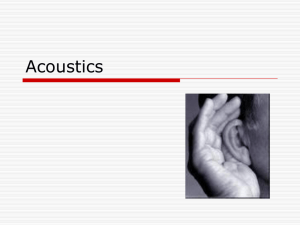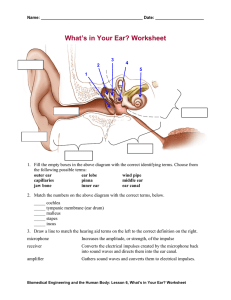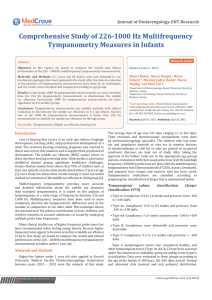A Normative Study on Wideband Tympanometry and Energy
advertisement
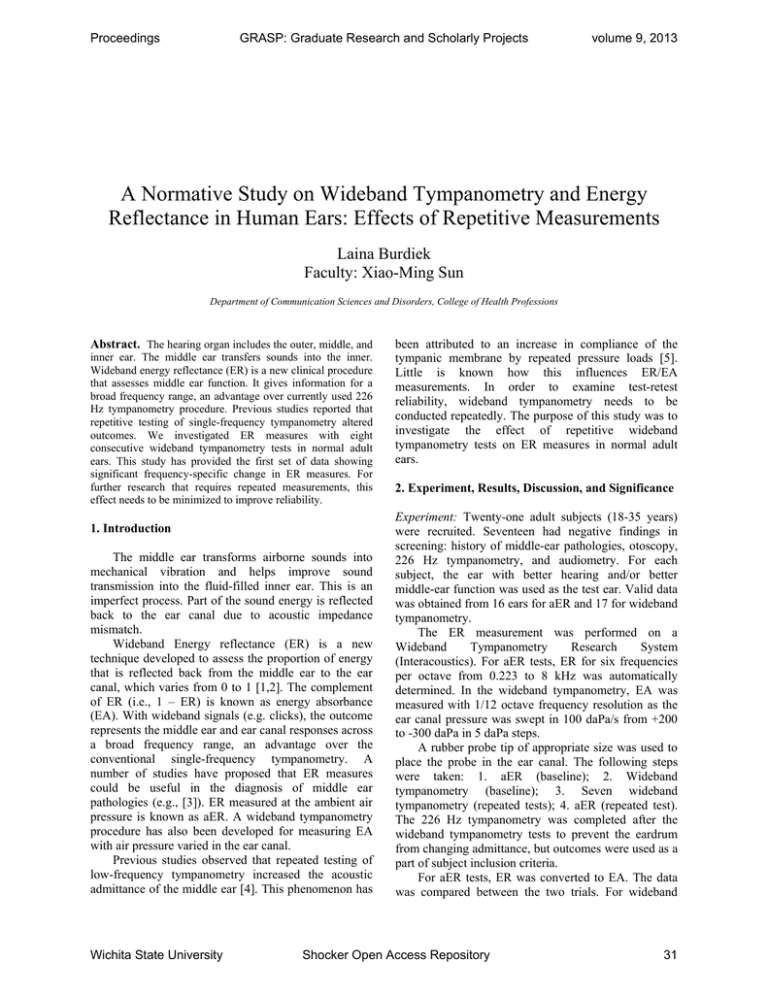
Proceedings GRASP: Graduate Research and Scholarly Projects volume 9, 2013 A Normative Study on Wideband Tympanometry and Energy Reflectance in Human Ears: Effects of Repetitive Measurements Laina Burdiek Faculty: Xiao-Ming Sun Department of Communication Sciences and Disorders, College of Health Professions Abstract. The hearing organ includes the outer, middle, and inner ear. The middle ear transfers sounds into the inner. Wideband energy reflectance (ER) is a new clinical procedure that assesses middle ear function. It gives information for a broad frequency range, an advantage over currently used 226 Hz tympanometry procedure. Previous studies reported that repetitive testing of single-frequency tympanometry altered outcomes. We investigated ER measures with eight consecutive wideband tympanometry tests in normal adult ears. This study has provided the first set of data showing significant frequency-specific change in ER measures. For further research that requires repeated measurements, this effect needs to be minimized to improve reliability. 1. Introduction The middle ear transforms airborne sounds into mechanical vibration and helps improve sound transmission into the fluid-filled inner ear. This is an imperfect process. Part of the sound energy is reflected back to the ear canal due to acoustic impedance mismatch. Wideband Energy reflectance (ER) is a new technique developed to assess the proportion of energy that is reflected back from the middle ear to the ear canal, which varies from 0 to 1 [1,2]. The complement of ER (i.e., 1 – ER) is known as energy absorbance (EA). With wideband signals (e.g. clicks), the outcome represents the middle ear and ear canal responses across a broad frequency range, an advantage over the conventional single-frequency tympanometry. A number of studies have proposed that ER measures could be useful in the diagnosis of middle ear pathologies (e.g., [3]). ER measured at the ambient air pressure is known as aER. A wideband tympanometry procedure has also been developed for measuring EA with air pressure varied in the ear canal. Previous studies observed that repeated testing of low-frequency tympanometry increased the acoustic admittance of the middle ear [4]. This phenomenon has Wichita State University been attributed to an increase in compliance of the tympanic membrane by repeated pressure loads [5]. Little is known how this influences ER/EA measurements. In order to examine test-retest reliability, wideband tympanometry needs to be conducted repeatedly. The purpose of this study was to investigate the effect of repetitive wideband tympanometry tests on ER measures in normal adult ears. 2. Experiment, Results, Discussion, and Significance Experiment: Twenty-one adult subjects (18-35 years) were recruited. Seventeen had negative findings in screening: history of middle-ear pathologies, otoscopy, 226 Hz tympanometry, and audiometry. For each subject, the ear with better hearing and/or better middle-ear function was used as the test ear. Valid data was obtained from 16 ears for aER and 17 for wideband tympanometry. The ER measurement was performed on a Wideband Tympanometry Research System (Interacoustics). For aER tests, ER for six frequencies per octave from 0.223 to 8 kHz was automatically determined. In the wideband tympanometry, EA was measured with 1/12 octave frequency resolution as the ear canal pressure was swept in 100 daPa/s from +200 to -300 daPa in 5 daPa steps. A rubber probe tip of appropriate size was used to place the probe in the ear canal. The following steps were taken: 1. aER (baseline); 2. Wideband tympanometry (baseline); 3. Seven wideband tympanometry (repeated tests); 4. aER (repeated test). The 226 Hz tympanometry was completed after the wideband tympanometry tests to prevent the eardrum from changing admittance, but outcomes were used as a part of subject inclusion criteria. For aER tests, ER was converted to EA. The data was compared between the two trials. For wideband Shocker Open Access Repository 31 Proceedings GRASP: Graduate Research and Scholarly Projects tympanometry, EA as a function of frequency was derived for the ambient and peak pressure, respectively, and was compared across the eight trials. The peak pressure was determined using the bandpass tympanometric peak pressure (BTPP). A two-way repeated measure ANOVA was performed to test the significance of difference. An α level of 0.05 was used. Results: From wideband tympanometry data at both ambient pressure and BTTP (peak), mean EA change verses frequency function for Test 2 to 8 was calculated relative to Test 1. At the ambient pressure, EA tended to increase below 1.5 kHz, decease from 1.5 to 3 kHz, and decrease again at 5 to 6 kHz. At BTTP, EA tended to increase for low frequencies with the maximal change at 0.7 to 0.8 kHz. It tended to decease between 1 and 3 kHz and decrease at around 5 kHz. This frequency specific trend was similar across all repeated tests. Mean EA change versus frequency function for Test 8 at the ambient pressure is shown with ± 1 SD in Fig. 1 (panel A). There was a statistically significant increase of EA at 0.707 and 1 kHz and decrease at 2 kHz (p<0.05, 2-way RM ANOVA). When the same analysis was completed for data at BTTP (not shown), there was a significant increase at 0.5 and 0.707 kHz and decrease at 1.414 and 2 kHz (p<0.05). volume 9, 2013 significant increase at 0.707 and 1 kHz (p<0.05, 2-way RM ANOVA). The low frequency change in EA was much larger in aER tests than the change in EA measured from wideband tympanometry tests. Discussion: With repetitive wideband tympanometry, EA changes in a frequency specific manner: increase in low frequencies and decrease in certain high frequencies. The changes in EA in low frequencies are larger in aER tests. This phenomenon in ER measurements for low frequencies is in agreement with observed in previous studies using the single-frequency tympanometry. [4, 5] Significance: This study has provided the first set of data showing a statistically significant effect of repeated wideband tympanometry on ER measures. 3. Conclusions This study investigated the effect of repetitive wideband tympanometry on ER measures. Our study revealed frequency-specific changes in EA. Results suggest that this effect should be taken into account, or be minimized, to improve reliability when repetitive wideband tympanometry is required in applications, for instance, in test-retest studies. Acknowledgements This study is a collaborative work conducted in the Auditory Research Laboratory of Xiao-Ming Sun and partially supported by WSU in the form of a Special Research Fellowship for Student Travel (2013). Portions of this work were presented at the 10th Annual Capitol Graduate Research Summit (Topeka, KS, Feb. 14) and the American Academy of Audiology Annual Convention (Anaheim, CA, April 3-6). References Mean change in EA at the ambient pressure as a function of test sequence, relative to Test 1, is displayed in Fig. 1 (panel B, C) for 11 half-octave frequencies. There tended to be an increase in EA in the low frequencies (panel B) and a decrease in the high frequencies (panel C). For frequencies where EA increased or decreased, in general the change enlarged gradually over the tests. For the repeated aER tests, the EA change relative to the baseline followed a similar pattern to the wideband tympanometry data at the ambient pressure. The EA tended to increase in low frequencies and decrease in high frequencies. There was a statistically Wichita State University [1]Keefe, D. H., Ling, R., & Bulen, J. C. (1992). “Method to measure acoustic impedance and reflectance coefficient,” J. Acoust. Soc. Am., 91, 470–485. [2] Voss, S. E. & Allen, J. B. (1994). “Measurement of acoustic impedance and reflectance in the human ear canal,” J. Acoust. Soc. Am., 95, 372–384. [3]Allen, J. B., Jeng, P. S., & Levitt, H. (2005). “Evaluation of human middle ear function via an acoustic power assessment,” J. Rehab. Res. Dev., 42, 63–78. [4]Wilson, R. H., Shanks, J. E., & Kaplan, S. K. (1984). “Tympanometric changes at 226 Hz and 678 Hz across 10 trials and for two directions of ear canal pressure change,” J. Speech. Hear. Res., 27, 257–266. [5]Gaihede, M. (1996). “Tympanometric preconditioning of the tympanic membrane,” Hear. Res., 102, 28–34. Shocker Open Access Repository 32
